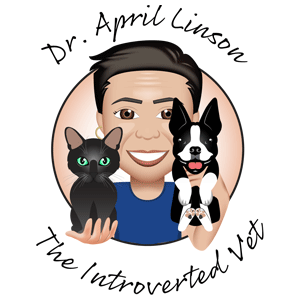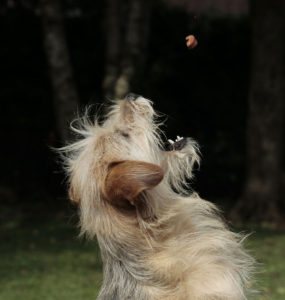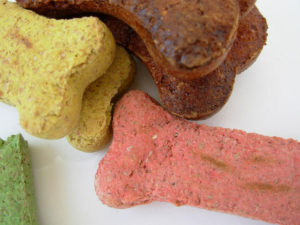At A Glance
- Commercially prepared pet food has been around for about 70 years with the majority of growth in the past 3-4 decades.
- Dry pet food entered the scene about the same time that manufacturers introduced more processed human food.
- The first dog biscuits created in the mid-late 1800s were the first commercial dog food
- In the 1920’s, dehydrated meals, pellets, and canned foods from meat and grain mill scraps became the basis for commercial pet foods we know today. These first commercial pet foods were marketed to wealthy pet owners. Most families still fed their pets primarily raw meat and table scraps which supplemented what the animal could hunt. Canned foods became very popular and accounted for over 90% of the small commercial pet food market at that time.
- Changes occurring during WWII & post-war boom economic expansion led to the popularity of commercially processed kibble.
The First Commercial Pet Food
In 1860, a salesman named James Spratt traveled to London. While there, he saw British sailors feeding hard tack to stray dogs. Hard tack is made of flour, water and salt and was a staple food for sailors and soldiers who often didn’t have time to prepare food. Mr. Spratt worked with a bakery to develop a “dog cake”. The dog cake was a success in England and Mr. Spratt introduced the product to wealthy Americans in 1895. Then in 1907, an American competitor created a biscuit in the shape of a bone and until 1922, these two biscuits were the only commercial dog food.
1920s-1930s
Most companion animals ate primarily raw meat and table scraps, plus what they foraged in the 1920s. However, new options for commercial pet foods were created. Interestingly, these commercial pet foods were not readily affordable, so wealthy Americans were the primary market. Initially, canned food contained horse meat. Due to public outcry, Congress ended the use of horse meat in pet food and other meat sources were found. During the Depression, commercial pet food production expanded, with canned food seeing the biggest increase in a still small pet food market. There was virtually no regulation of pet food formulation or preparation.
WWII
During WWII, there were a number of factors that created significant change in the pet food industry. Until the war, canned food had the majority of the commercial pet food market. When WWII began, metal and glass were vital to weapons production. Pet food was classified as non-essential and the canned pet food industry was essentially wiped out. Food rationing and women entering the work force led to less table scraps. Families began to purchase dry foods and biscuits for convenience and due to the lack of canned food or scraps from home prepared meals.
In the 1930s, Spam was created, as well as other processed Hormel products. These products were portable and had a good shelf life. 65% of Hormel sales during WWII were to the US military. Americans were now introduced to processed food and this would have a huge impact on human and pet food in future decades.
Post War America
War related growth and innovation created employment opportunities not available before the war. The GI bill led to many Americans getting advanced degrees and purchasing homes. Suburbia replaced corner markets with supermarkets that had processed foods and a wide selection of meat, milk, and eggs. The fast food industry developed with this new wealth and the busy lifestyle, often with two adults working, led to greater demand for convenience. This increase in consumer demand led to large quantities of agricultural scraps from the slaughterhouses, mills and processing plants. Commercial pet food companies saw these scraps as an opportunity.
In the 1950s, one pet food company discovered a method for taking a hot liquid soup of meat, fat and grain scraps and injecting them through another heat process (called extrusion), which turned the fluid into kibbled dry food. This discovery added the mass market capability necessary to meet consumer preference for dry food at an affordable price for the average pet owner.
1960s and beyond
Now pet food companies were able to mass market kibble using waste products from the human food industry or products never meant for human consumption. What type of ingredients are we talking about? Un-inspected waste from the seafood industry, grains that didn’t pass inspection for human use, restaurant grease, deceased livestock and roadkill is collected and disposed of by rendering. Rendering is a process that converts many types of human food industry waste into raw materials for pet food.
When these ingredients are extruded to create kibble, rendered raw materials are blended with starch fillers. Bulk vitamin and mineral supplements are added and the mixture is extruded at high temperatures. This high temperature processing of these less-than-ideal ingredients results in numerous toxic reactions leaving us with acrylamides and heterocyclic amines, which are potent carcinogens.
Kibble contains glycotoxins, which can create massive amounts of inflammation. Even when we think we’re purchasing a very healthy kibble that may have contained good quality ingredients in the original form, the extreme processing of the kibble creates carcinogenic substances in the finished product.
There’s also a significant lack of moisture in kibble, which results in clinical dehydration in dogs and definitely in cats. Long term dehydration results in organ degeneration.
Canned foods have more moisture, but the ingredients are still enzyme deficient and processed. Enzymes are so important in systemic health & managing inflammation, so the canned diets are not truly better for our companions.
Now we have hundreds of kibble foods, canned and semi-moist dog and cat foods. We also have more pets with chronic inflammatory diseases such as chronic skin issues (allergies, atopy), chronic bowel issues (IBD, IBS, chronic parasitism), endocrine diseases (diabetes, hypothyroidism, hyperthyroidism, etcetera), and cancers of all types. While I believe it’s too simplistic to say diet is the only cause of these issues, I also believe we can’t deny that nutrition and diet play a huge role in animal wellness, just as it they do in human wellness.
Sources:



